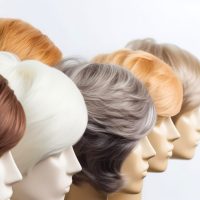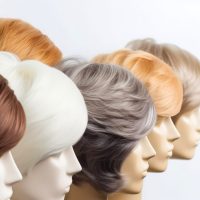News
The Ultimate Guide to Combatting Baldness
Are you tired of watching your hair slowly thinning and seeing bald patches emerge?
It’s an issue that affects millions of people around the world, both men and women alike. But fear not! We have the ultimate guide to combatting baldness and saying goodbye to thinning hair for good.
In this comprehensive blog post, we will delve into the various causes of baldness, uncover the myths surrounding hair loss, and provide you with practical tips and solutions to regrow and maintain a healthy head of hair. Baldness can be a distressing and confidence-damaging experience. It can make us feel self-conscious, older than our years, and even impact our social and professional lives.
But before we dive into the solutions, let’s first understand the underlying causes of baldness. Contrary to popular belief, it’s not just a matter of genetics. While genetics does play a role, there are other factors at play, such as hormonal imbalances, nutritional deficiencies, stress, and even certain medical conditions.
By understanding these causes, we can better equip ourselves with the knowledge to combat and prevent further hair loss. Now, you may have heard of countless remedies and miracle products claiming to regrow hair overnight. But let’s face it – most of them are nothing more than empty promises. That’s why we’ve sifted through the noise and compiled the most effective and scientifically-backed strategies to combat baldness. From lifestyle adjustments, dietary changes, and scalp treatments to natural remedies, hair growth supplements, and advanced medical procedures, we’ll explore all the options available to you. So get ready to bid farewell to thinning hair and embrace a vibrant, full head of hair that will make you feel confident and unstoppable. But wait, that’s not all!
We’ll also address common concerns and misconceptions about baldness and hair loss along the way. Can wearing hats cause baldness? Do hair products play a role in hair loss? Is there any truth to the idea that excessive shampooing can lead to baldness? We’ll debunk the myths and provide you with evidence-based answers that will put your mind at ease. So whether you’re currently battling baldness or simply looking to maintain a healthy head of hair, this ultimate guide has got you covered.
Get ready to embark on a journey of discovery, uncover the secrets to combatting baldness, and reclaim your confidence. Say goodbye to thinning hair and hello to a new chapter of hair growth and vitality. Let’s dive in!
Understanding the Causes of Baldness
Baldness is a common condition that affects both men and women. While genetics does play a significant role in determining whether or not someone will experience hair loss, there are other factors at play as well. Understanding the causes of baldness can help us better address the issue and find effective solutions.
One of the primary causes of baldness is hormonal imbalances. Hormones, such as dihydrotestosterone (DHT), can contribute to hair loss by shrinking hair follicles and shortening the growth phase of the hair cycle. This hormonal imbalance can be influenced by factors like age, genetics, and certain medical conditions.
Nutritional deficiencies can also impact hair health and contribute to baldness. Our hair requires essential nutrients like vitamins A, B, C, D, E, iron, zinc, and protein to grow strong and healthy. When we lack these nutrients in our diet or have difficulty absorbing them due to digestive issues, it can lead to weakened hair follicles and eventual hair loss.
Stress is another significant factor that can contribute to baldness. When we experience stress, our bodies produce higher levels of cortisol – a hormone that can disrupt the normal functioning of our hair follicles. This disruption can lead to increased shedding and thinning of the hair.
In addition to these factors, certain medical conditions can also cause baldness. Conditions like alopecia areata (an autoimmune disease), thyroid disorders, scalp infections, and even cancer treatments like chemotherapy can result in significant hair loss.
The Role of Genetics in Baldness
Genetics plays a crucial role in determining whether or not someone will experience baldness. If you have close family members who have experienced hair loss or thinning hair, there’s a higher chance that you may also be genetically predisposed to baldness.
Genetic baldness, also known as androgenetic alopecia, is the most common form of hair loss. It typically follows a specific pattern, with men experiencing a receding hairline and thinning crown, while women may notice overall thinning of the hair. This type of baldness is caused by a combination of genetic factors and the hormone DHT.
While we can’t change our genetics, understanding our genetic predisposition to baldness can help us take proactive steps to prevent further hair loss and promote healthy hair growth.
Hormonal Imbalances and Hair Loss
Hormonal imbalances can have a significant impact on our hair health and contribute to baldness. One hormone in particular – dihydrotestosterone (DHT) – plays a crucial role in male pattern baldness.
DHT is derived from testosterone through an enzyme called 5-alpha reductase. In individuals who are genetically predisposed to baldness, DHT binds to receptors in the scalp’s hair follicles, causing them to shrink over time. This shrinkage leads to shorter and finer hairs until eventually, the follicles stop producing new hairs altogether.
In women, hormonal imbalances such as polycystic ovary syndrome (PCOS) can also contribute to hair loss. PCOS is characterized by an excess of male hormones (androgens) in the body, which can lead to thinning of the hair on the scalp.
Addressing hormonal imbalances through medical interventions or lifestyle changes can help slow down or even reverse hair loss caused by hormonal factors.
Nutritional Deficiencies and Hair Health
The saying “you are what you eat” holds true when it comes to our hair health as well. Nutritional deficiencies can contribute to hair loss and baldness.
Our hair requires a variety of nutrients to grow strong and healthy. These include vitamins, minerals, and proteins. When we lack these essential nutrients in our diet, it can lead to weakened hair follicles and eventual hair loss.
Vitamin deficiencies, such as vitamin D or B vitamins, can impact the health of our hair. Vitamin D deficiency has been linked to alopecia areata – an autoimmune condition that causes patchy hair loss. B vitamins, on the other hand, play a crucial role in promoting healthy hair growth.
Mineral deficiencies like iron and zinc can also contribute to hair loss. Iron is necessary for carrying oxygen to the hair follicles, while zinc plays a role in DNA and protein synthesis – both essential processes for healthy hair growth.
Ensuring a well-balanced diet that includes plenty of fruits, vegetables, lean proteins, and whole grains can help prevent nutritional deficiencies and promote optimal hair health.
The Impact of Stress on Hair Loss
We’ve all experienced stress at some point in our lives – whether it’s due to work pressures, relationship issues, or personal challenges. But did you know that stress can also contribute to hair loss?
When we’re under stress, our bodies produce higher levels of cortisol – often referred to as the “stress hormone.” Elevated cortisol levels can disrupt the normal functioning of our hair follicles and lead to increased shedding and thinning of the hair.
In some cases, extreme stress or traumatic events can trigger a condition called telogen effluvium. This condition causes a large number of hairs to enter the resting phase (telogen) prematurely and eventually fall out. The good news is that this type of hair loss is usually temporary and resolves itself once the underlying stressor is addressed.
Managing stress through relaxation techniques, exercise, and self-care practices can help minimize its impact on our hair health and prevent further hair loss.
Medical Conditions and Hair Loss
While genetics and hormonal imbalances are common causes of baldness, certain medical conditions can also contribute to hair loss.
Alopecia areata is an autoimmune condition that causes patchy hair loss. It occurs when the immune system mistakenly attacks the hair follicles, leading to inflammation and subsequent hair loss. The exact cause of alopecia areata is unknown, but it’s believed to be a combination of genetic and environmental factors.
Thyroid disorders, such as hypothyroidism or hyperthyroidism, can also impact hair health. Both an underactive thyroid (hypothyroidism) and an overactive thyroid (hyperthyroidism) can lead to thinning or brittle hair.
Scalp infections like ringworm can cause temporary bald patches. These infections are typically caused by fungi that thrive in warm and moist environments. Treating the underlying infection usually leads to regrowth of the affected hair.
Certain medications or medical treatments like chemotherapy can also result in significant hair loss. Chemotherapy drugs target rapidly dividing cells – including cancer cells but also the cells responsible for hair growth. This leads to widespread hair loss during treatment, but in most cases, the hair will grow back once treatment is completed.
Lifestyle Adjustments for Hair Growth
Making certain lifestyle adjustments can help promote healthy hair growth and prevent further baldness. Here are some tips:
Avoid tight hairstyles: Pulling your hair tightly into ponytails or braids can put unnecessary stress on your follicles and lead to traction alopecia – a type of hair loss caused by tension on the hair shafts.
Be gentle with your hair: Avoid excessive brushing, combing, or towel-drying your hair, as these actions can cause breakage and damage to the hair shafts.
Avoid heat styling: Excessive use of heat styling tools like flat irons and curling irons can weaken the hair and lead to breakage. If you must use these tools, apply a heat protectant spray beforehand and use them on the lowest heat setting possible.
Protect your hair from the sun: Just like our skin, our hair can also be damaged by prolonged sun exposure. Wear a hat or use a leave-in conditioner with UV protection when spending time outdoors.
Maintain a healthy scalp: A clean and well-nourished scalp is essential for healthy hair growth. Regularly shampooing your scalp and using a conditioner can help keep it clean and moisturized.
Dietary Changes to Promote Hair Health
The food we eat plays a crucial role in our overall health – including the health of our hair. Making dietary changes to include nutrient-rich foods can promote healthy hair growth and combat baldness.
Eat a balanced diet: Ensure that your diet includes a variety of fruits, vegetables, whole grains, lean proteins, and healthy fats. These foods provide essential vitamins, minerals, antioxidants, and proteins that are necessary for healthy hair growth.
Increase your intake of omega-3 fatty acids: Omega-3 fatty acids are found in fatty fish like salmon, mackerel, and sardines. They help nourish the scalp and promote healthy hair growth.
Incorporate foods rich in biotin: Biotin, also known as vitamin H, is essential for healthy hair growth. Foods like eggs, nuts, seeds, and sweet potatoes are excellent sources of biotin.
Include iron-rich foods: Iron is necessary for carrying oxygen to the hair follicles. Incorporate iron-rich foods like lean meats, leafy green vegetables, legumes, and fortified cereals into your diet.
Stay hydrated: Drinking an adequate amount of water each day helps keep your scalp and hair hydrated. Aim for at least eight glasses of water per day.
Scalp Treatments for Hair Regrowth
In addition to lifestyle adjustments and dietary changes, certain scalp treatments can help promote hair regrowth and combat baldness.
Minoxidil: Minoxidil is an FDA-approved topical medication that can help stimulate hair growth. It’s available over-the-counter in various strengths and formulations. Applying minoxidil to the scalp twice daily can help slow down or even reverse hair loss in some individuals.
Platelet-rich plasma (PRP) therapy: PRP therapy involves injecting a concentrated solution of platelets from your own blood into the scalp. Platelets contain growth factors that can stimulate hair follicles and promote new hair growth.
Laser therapy: Low-level laser therapy (LLLT) uses red light wavelengths to stimulate blood flow to the scalp and promote hair growth. This non-invasive treatment can be done at home using handheld devices or in specialized clinics.
Natural Remedies for Combating Baldness
If you prefer natural remedies over medical interventions, several options may help combat baldness:
Essential oils: Essential oils like rosemary, peppermint, and lavender have been traditionally used to promote hair growth. Dilute a few drops of your chosen essential oil in a carrier oil (such as coconut or jojoba oil) and massage it into your scalp.
Aloe vera: Aloe vera gel has soothing properties and can help maintain a healthy scalp. Apply fresh aloe vera gel directly to your scalp and leave it on for 30 minutes before rinsing.
Onion juice: Onion juice contains sulfur compounds that may help stimulate hair follicles and promote hair growth. Apply freshly squeezed onion juice to your scalp, leave it on for 15-30 minutes, then rinse thoroughly.
Ginseng: Ginseng has been used in traditional medicine for centuries and is believed to promote hair growth. You can take ginseng supplements or apply ginseng-infused products directly to your scalp.
Hair Growth Supplements: Do They Work?
Hair growth supplements are often marketed as miracle solutions for baldness. While some supplements may provide benefits, it’s essential to approach them with caution.
The effectiveness of hair growth supplements varies depending on the individual and the specific supplement being used. Some popular ingredients found in these supplements include biotin, vitamins A, C, D, E, iron, zinc, and various herbal extracts.
If you’re considering taking hair growth supplements, it’s best to consult with a healthcare professional who can assess your specific needs and recommend appropriate options. They can also help determine if any underlying nutritional deficiencies are contributing to your hair loss.
Advanced Medical Procedures for Restoring Hair
In cases where baldness is more advanced or other treatments have not been effective, advanced medical procedures may be considered:
Hair transplant surgery: Hair transplant surgery involves removing hair follicles from areas of the scalp with healthy hair growth (donor area) and implanting them into areas with thinning or no hair (recipient area). This procedure can provide long-lasting and natural-looking results.
Scalp micropigmentation: Scalp micropigmentation is a non-surgical procedure that uses micro-needles to deposit pigments into the scalp, creating the appearance of a shaved head or fuller hair. It’s an excellent option for individuals who prefer a buzzed or shaved hairstyle.
Low-level laser therapy (LLLT): As mentioned earlier, LLLT can stimulate blood flow to the scalp and promote hair growth. In advanced cases of baldness, LLLT devices with more extensive coverage may be used to target larger areas of the scalp.
Debunking Common Myths About Baldness
Baldness is surrounded by numerous myths and misconceptions. Let’s debunk some of the most common ones:
Myth: Wearing hats causes baldness: Wearing hats does not cause baldness. However, wearing tight hats for extended periods can lead to traction alopecia – a type of hair loss caused by tension on the hair shafts.
Myth: Hair products cause baldness: While certain harsh chemicals in hair products can damage the hair shafts and lead to breakage, they do not directly cause baldness. It’s essential to choose gentle and nourishing products that suit your specific hair type.
Myth: Excessive shampooing causes baldness: Shampooing your hair regularly does not cause baldness. In fact, keeping your scalp clean and free from excess oil and debris can promote a healthy environment for hair growth. However, using harsh shampoos or washing your hair too vigorously can damage the hair shafts.
Conclusion: Reclaim Your Confidence and Say Goodbye to Thinning Hair
Baldness can be a distressing experience, but it’s important to remember that you’re not alone. Millions of people around the world are facing the same challenges. By understanding the causes of baldness and exploring the various solutions available, you can take proactive steps to combat hair loss and reclaim your confidence.
In this ultimate guide, we’ve covered everything from the role of genetics in baldness to hormonal imbalances, nutritional deficiencies, stress, medical conditions, lifestyle adjustments, dietary changes, scalp treatments, natural remedies, hair growth supplements, advanced medical procedures, and common myths surrounding baldness.
Remember that finding the right solution for your specific needs may require some trial and error. It’s essential to consult with healthcare professionals or specialists who can provide personalized advice based on your unique circumstances.
Don’t let thinning hair hold you back – embrace this journey of discovery and take control of your hair health. With patience and perseverance, you can say goodbye to baldness and hello to a vibrant head of hair that makes you feel confident and unstoppable!
-
TOUPEE 4ASH
$279.99 -
TOUPEE CPE-BA-08 1B50
$279.99 -
TOUPEE HRS-WU-20 17
$279.99 -
TOUPEE LLS-WU-01 7
$279.99 -
TOUPEE LLS-WU-D1 1B AUTRALIA
$259.99 -
TOUPEE MWS-ER 22 7
$279.99




